97th Air Refueling Squadron
97th Air Refueling Squadron
 | |
|---|---|
 One of the squadron's boom operators conducts an aerial refueling of a C-17 Globemaster III over Washington, 2020 | |
| Active | 1941–1946; 1949–1964; 1964–1992; 1992–2004; 2019–present |
| Country | |
| Branch | |
| Role | Air Refueling |
| Part of | Air Mobility Command |
| Garrison/HQ | Fairchild Air Force Base, Washington |
| Motto(s) | Pro Potentia Inter Astra (Latin: "For Strength Among the Stars") |
| Engagements | Mediterranean Theater of Operations |
| Decorations | Distinguished Unit Citation Air Force Meritorious Unit Award Air Force Outstanding Unit Award |
| Insignia | |
| 97th Air Refueling Squadron emblem (approved 9 December 1994)[1] | 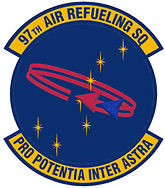 |
| 97th Air Refueling Squadron emblem (approved 10 September 1965)[1] |  |
| 97th Air Refueling Squadron emblem (approved 2 November 1955)[1] | 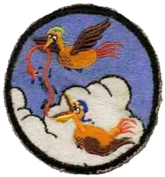 |
| 97th Bombardment Squadron emblem (approved 9 August 1944)[2] |  |
The 97th Air Refueling Squadron is an active unit of the United States Air Force, stationed at Fairchild Air Force Base, Washington. It was most recently activated on 1 October 2019 and assigned to the 92nd Operations Group, 92nd Air Refueling Wing.
The squadron was first activated in January 1941 as the 20th Reconnaissance Squadron. Seven months after activation, it was renamed the 97th Bombardment Squadron and assigned to the 47th Bombardment Group. It performed antisubmarine patrols off the Pacific coast following the entry of the United States into World War II. Three months later, it began training for light bomber operations, and in November 1942 it deployed to the Mediterranean Theater of Operations. The squadron engaged in combat in northern Africa, Italy and France until V-E Day, earning two Distinguished Unit Citations for its actions there. The 97th returned to the United States in the summer of 1945 and was inactivated at Lake Charles Army Air Field, Louisiana in March 1946.
The 97th Air Refueling Squadron was one of the Air Force's first air refueling units, activated in 1949. It was active continuously until 2004, except for brief interruptions in 1964 and 1992. The squadron served with Boeing KB-29s until 1954 at Biggs Air Force Base, Texas, when it upgraded to Boeing KC-97 Stratofreighters. In 1957 it moved north to Malmstrom Air Force Base, Montana, where it served until 1964 when the KC-97 was being phased out of the active force inventory.
The squadron was soon activated with Boeing KC-135 Stratotankers at Blytheville Air Force Base, Arkansas. In 1985, the two squadrons were consolidated there into a single unit. The consolidated squadron provided crews and aircraft to Strategic Air Command (SAC) units in the Pacific during the Vietnam War and deployed elements that served in Desert Storm. In 1992, it was inactivated as SAC was closing what had been renamed Eaker Air Force Base.
The squadron was again activated a few months later, returning to Malmstrom as part of Air Mobility Command's tanker fleet. It moved to Fairchild Air Force Base, Washington two years later and remained there until its inactivation in 2004.
History
[edit]World War II
[edit]The squadron was first activated as the 20th Reconnaissance Squadron at McChord Field, Washington in January 1941, attached to the 17th Bombardment Group, and equipped with Douglas B-18 Bolos. In May, it was attached to the 47th Bombardment Group and was assigned to the 47th group and redesignated the 97th Bombardment Squadron in August.[1][2][3]
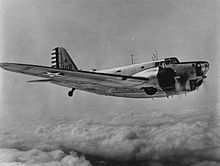
After the Pearl Harbor Attack it was equipped with Douglas DB-7 Bostons and early-model Consolidated B-24 Liberators,[note 1] to perform antisubmarine patrols along the Pacific coast. In February 1942, with a Japanese submarine attack unlikely, the squadron moved to Will Rogers Field, Oklahoma, re-equipped with Douglas A-20 Havoc light bombers and trained for overseas deployment.[2][3]
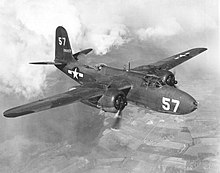
In November 1942, the 97th deployed to French Morocco as part of Operation Torch, the invasion of French North Africa. The squadron engaged in close air support and air interdiction missions during the North African Campaign. It began operations by flying low-level missions in December, continuing these tactics through May 1943.
In February 1943, the Afrika Corps broke through American lines at the Kasserine Pass. Although the unit was undermanned and short of supplies it flew missions on 22 February against advancing enemy armor, helping to blunt the enemy attack. For this action, the 97th was awarded the Distinguished Unit Citation.[3][4]
The squadron remained active in combat, but also trained for medium altitude bombing missions in April and May. In June 1943 it participated in the reduction of the islands of Pantelleria and Lampedusa. In July, the unit participated in Operation Husky, the invasion of Sicily, attacking German forces evacuating the island from beaches near Messina the following month.[3] September 1943 saw the launch of Operation Avalanche, the invasion of Italy. During Avalanche, the squadron provided support for the British Eighth Army. It participated in the Italian Campaign and advance toward Rome until the spring of 1944.
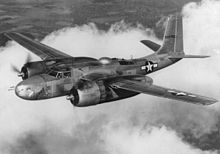
In August and September 1944, the unit provided support for Operation Dragoon, the invasion of southern France.
The squadron then returned to Italy, where it attacked German communications and other targets, including tanks, bivouac areas, supply dumps, troop concentrations, roads, bridges, airfields and railways.[3]
The 97th upgraded to Douglas A-26 Invaders in early 1945. In April 1945, the squadron and the rest of the 47th group maintained attacks on enemy transportation in the Po River Valley for sixty consecutive hours despite bad weather and adverse terrain. The attacks prevented the orderly withdrawal of German forces from northern Italy. For this action, the squadron earned a second Distinguished Unit Citation.[3]
The squadron returned to the United States in July 1945, and was initially stationed at Seymour Johnson Field, North Carolina. It moved to Lake Charles Army Air Field in September, where it trained as a pathfinder unit.[2][5]
The unit remained active until March 1946, when the 47th group reduced from four to three squadrons.[3]
Air Refueling
[edit]Propeller-driven tankers in Texas and Montana
[edit]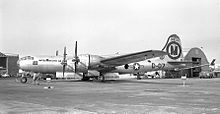
The 97th Air Refueling Squadron was activated in March 1949 and assigned to the 97th Bombardment Group at Biggs Air Force Base, Texas. The squadron was initially equipped with the Boeing KB-29M Superfortress. The KB-29M was equipped with a hose system developed by the British in which the tanker trailed a hose to the receiver and fuel was gravity-fed. The tanker trailed a "hauling line" which was trapped by the receiver, reeled in and attached to the receiver fuel system. The system was perilous and the KB-29Ms were retired in a few years.
On 1 September 1950, the squadron was the first to receive the improved KB-29P, which was equipped with a boom and used pumps to deliver the fuel more rapidly.[6] However, the squadron remained below strength until 1952.[7]

The squadron upgraded to Boeing KC-97 Stratofreighters in 1954. The unit frequently deployed from Biggs to England, Newfoundland and Labrador, completing its last unit deployment as it was moving to Montana.[1] In the mid-1950s, Strategic Air Command (SAC) began to move its KC-97 refueling strength to the northern United States.[8] The move to Montana-based the squadron ahead of the faster Boeing B-47 Stratojets it would refuel, and on their programmed route.[9]
In 1957, the squadron moved to Malmstrom Air Force Base to fill out the 4061st Air Refueling Wing, which had been formed the previous month with the 407th Air Refueling Squadron.[10] During the 1958 Lebanon Crisis, the squadron provided support for the 92d Bombardment Wing.[11] In July 1961, the 4061st wing was inactivated and the 97th was assigned to the 9th Bombardment Wing at Mountain Home Air Force Base, although it remained at Malmstrom and was attached to the host 341st Combat Support Group there.[12] It was discontinued in March 1964 as part of the phaseout of KC-97 aircraft from the active duty force.[1]
Jet tankers in Arkansas
[edit]The 97th ARS was redesignated as a heavy unit and organized on 8 October 1964 at Blytheville Air Force Base, Arkansas, where it assumed the mission, personnel and Boeing KC-135 Stratotankers of the 914th Air Refueling Squadron, which was simultaneously inactivated.[13] The squadron provided air refueling primarily to the Boeing B-52 Stratofortresses of the 97th Bombardment Wing, Heavy, which had also moved from Texas almost five years prior.[14] One half of the squadron's aircraft were maintained on fifteen-minute alert, fully fueled and ready for combat to reduce vulnerability to a Soviet missile strike.[15]
In addition to its alert commitment, the squadron deployed aircraft and aircrews to support Tanker Task Forces in Europe, the Pacific and Alaska.[16] During the Vietnam War, from the mid 1960s, the squadron deployed forces to the Pacific to other units to support Operation Arc Light and Operation Rolling Thunder. By mid-1972 all of the squadron's tankers were operating with other Strategic Air Command units in the Pacific.[17] In September 1985, the 97th was consolidated with the 97th Bombardment Squadron into a single unit. In 1990, the consolidated squadron flew 93 sorties in direct support of Desert Shield and Desert Storm.[18] It deployed to the Persian Gulf area, where it supported the 801st Bombardment Wing (Provisional) and the 802d Air Refueling Wing (Provisional).[19] The squadron remained active until April 1992, when it was inactivated as Eaker Air Force Base was closing.[1]
The squadron returned to Malmstrom Air Force Base when it was reactivated in October 1992. At Malmstrom, it was equipped with the re-engined KC-135R tankers.[20] The squadron continued to support deployed Tanker Task Forces throughout the world, including periodic support for the 1700th Strategic Wing (Provisional) in Riyadh, Saudi Arabia.[18] It also participated in Operation Restore Hope in Somalia. The squadron moved to Fairchild Air Force Base, Washington in July 1994 as Air Mobility Command reorganized its refueling units. It remained active there until September 2004.[1]
The squadron activated at Fairchild AFB on 18 October 2019 with the Boeing KC-135 Stratotanker.[21]
Lineage
[edit]97th Bombardment Squadron
- Constituted as the 20th Reconnaissance Squadron (Light) on 20 November 1940
- Activated on 15 January 1941
- Redesignated 97th Bombardment Squadron (Light) on 14 August 1941
- Redesignated 97th Bombardment Squadron, Light on 20 August 1943
- Inactivated on 31 March 1946
- Consolidated with the 97th Air Refueling Squadron as the 97th Air Refueling Squadron on 19 September 1985[1]
97th Air Refueling Squadron
- Constituted as the 97th Air Refueling Squadron, Medium on 2 February 1949
- Activated on 1 March 1949
- Discontinued and inactivated on 15 March 1964
- Redesignated 97th Air Refueling Squadron, Heavy and activated on 8 October 1964 (not organized)
- Organized on 23 October 1964
- Consolidated with the 97th Bombardment Squadron on 19 September 1985
- Redesignated 97th Air Refueling Squadron on 1 September 1991
- Inactivated on 1 April 1992
- Activated on 1 October 1992
- Inactivated on 30 September 2004
- Activated on 1 October 2019[1]
Assignments
[edit]- General Headquarters Air Force (later, Air Force Combat Command), 15 January 1941 (attached to 17th Bombardment Group until 7 May 1941, then 47th Bombardment Group)
- 47th Bombardment Group, 14 August 1941 – 31 March 1946
- 97th Bombardment Group, 1 March 1949 (attached to 97th Bombardment Wing after 12 July 1950)
- 97th Bombardment Wing, 16 June 1952 (attached to Fifteenth Air Force, c. 31 May 1955 – 10 July 1955)
- 4061st Air Refueling Wing, 1 September 1957
- 9th Bombardment Wing (later 9th Strategic Aerospace Wing) (attached to 341st Combat Support Group), 15 July 1961
- 28th Bombardment Wing, 1 July 1962 – 15 March 1964
- Strategic Air Command, 8 October 1964 (not organized)
- 97th Bombardment Wing, 23 October 1964
- 97th Operations Group, 1 September 1991 – 1 April 1992
- 43rd Operations Group, 1 October 1992
- 453rd Operations Group, 1 April 1994
- 92nd Operations Group, 1 July 1994 – 30 September 2004
- 92nd Operations Group, 1 October 2019 – present[1]
Stations
[edit]
|
|
Aircraft
[edit]- Douglas B-18 Bolo (1941–1942)
- Consolidated B-24 Liberator (1941–1942)
- Douglas DB-7 Boston (1942)
- Douglas A-20 Havoc (1942–1945)
- Douglas A-26 Invader (1945–1946)
- Boeing B-29 Superfortress (1950)
- Boeing KB-29 Superfortress (1950–1954)
- Boeing KC-97 Stratofreighter (1954–1964)
- Boeing KC-135 Stratotanker (1964–2004)
- Boeing KC-135 Stratotanker (2019–present)[23]
Awards and campaigns
[edit]| Award streamer | Award | Dates | Notes |
|---|---|---|---|
| Presidential Unit Citation | 22 February 1942 | North Africa, 97th Bombardment Squadron[4] | |
| Presidential Unit Citation | 21 April 1945 – 30 April 1945 | Po Valley, 97th Bombardment Squadron[2] | |
| Air Force Meritorious Unit Award | 1 June 2003 – 30 September 2004 | 97th Air Refueling Squadron[24] | |
| Air Force Outstanding Unit Award | 1 June 1955 – 1 September 1957 | 97th Air Refueling Squadron[1] | |
| Air Force Outstanding Unit Award | 2 July 1957 – 3 November 1957 | 97th Air Refueling Squadron[1] | |
| Air Force Outstanding Unit Award | 1 July 1975 – 30 June 1977 | 97th Air Refueling Squadron[1] | |
| Air Force Outstanding Unit Award | 1 July 1977 – 30 June 1978 | 97th Air Refueling Squadron[1] | |
| Air Force Outstanding Unit Award | 1 July 1978 – 30 June 1980 | 97th Air Refueling Squadron[1] | |
| Air Force Outstanding Unit Award | 1 July 1980 – 30 June 1982 | 97th Air Refueling Squadron[1] | |
| Air Force Outstanding Unit Award | 1 July 1986 – 30 June 1988 | 97th Air Refueling Squadron[1] | |
| Air Force Outstanding Unit Award | 1 July 1986 – 30 June 1988 | 97th Air Refueling Squadron[24] | |
| Air Force Outstanding Unit Award | 1 July 1995 – 30 June 1997 | 97th Air Refueling Squadron[24] | |
| Air Force Outstanding Unit Award | 1 January 1998 – 30 June 1999 | 97th Air Refueling Squadron[24] |
| Campaign Streamer | Campaign | Dates | Notes |
|---|---|---|---|
| Antisubmarine | 31 December 1941 – 15 February 1942 | 97th Bombardment Squadron[2][4] | |
| Algeria-French Morocco | 8 November 1942 – 11 November 1942 | 97th Bombardment Squadron[2] | |
| Tunisia | 12 November 1942 – 13 May 1943 | 97th Bombardment Squadron[2] | |
| Sicily | 14 May 1943 – 17 August 1943 | 97th Bombardment Squadron[2] | |
| Naples-Foggia | 18 August 1943 – 21 January 1944 | 97th Bombardment Squadron[2] | |
| Anzio | 22 January 1944 – 24 May 1944 | 97th Bombardment Squadron[2] | |
| Rome-Arno | 22 January 1944 – 9 September 1944 | 97th Bombardment Squadron[2] | |
| Southern France | 15 August 1944 – 14 September 1944 | 97th Bombardment Squadron[2] | |
| North Apennines | 10 September 1944 – 4 April 1945 | 97th Bombardment Squadron[2] | |
| Po Valley | 3 April 1945 – 8 May 1945 | 97th Bombardment Squadron[2] | |
| Air Combat, EAME Theater | 7 November 1942 – 11 May 1945 | 97th Bombardment Squadron[2] |
See also
[edit]- List of MAJCOM wings of the United States Air Force
- List of United States Air Force air refueling squadrons
References
[edit]Notes
[edit]- Explanatory notes
- ^ Some or all of the B-24s may have been LB-30s. Maurer, Combat Squadrons, p. 323
- Footnotes
- ^ a b c d e f g h i j k l m n o p q r s Musser, James M. (26 September 2022). "97 Air Refueling Squadron". Air Force Historical Research Agency. Archived from the original on 1 October 2022. Retrieved 2 October 2022.
- ^ a b c d e f g h i j k l m n o p Maurer, Combat Squadrons, pp. 322–323
- ^ a b c d e f g Maurer, Combat Units, pp. 104–106
- ^ a b c AF Pamphlet 900-2, Unit Decorations, Awards and Campaign Participation Credits, p. 270
- ^ "Abstract, History 97 Bombardment Squadron Sep 1945". Air Force History Index. Retrieved 10 October 2014.
- ^ Knaack, pp. 490–492
- ^ Smith, pp. 30–31
- ^ See Smith, p. 46
- ^ See Smith, p. 39
- ^ "Abstract, History 4061 Air Refueling Wing". Air Force History Index. 1 December 1957. Retrieved 9 October 2014.
- ^ "Abstract, History 4061 Air Refueling Wing Jul–Aug 1958". Air Force History Index. Retrieved 9 October 2014.
- ^ Mueller, p. 355
- ^ See Mueller, p. 38
- ^ Hartley, Jillian. "Eaker Air Force Base". Encyclopedia of Arkansas. Little Rock. Retrieved 13 December 2023.
- ^ "Abstract (Unclassified), History of the Strategic Bomber since 1945 (Top Secret, downgraded to Secret)". Air Force History Index. 1 April 1975. Retrieved 4 March 2014.
- ^ "Abstract, Vol. I, History 97 Bombardment Wing Jul–Sep 1983". Air Force History Index. Retrieved 10 October 2014.
- ^ Ravenstein, p. 138
- ^ a b "Abstract, Vol. I, History 97 Bombardment Wing Jul–Dec 1990". Air Force History Index. Retrieved 10 October 2014.
- ^ "Abstract, Vol. I, History 97 Bombardment Wing Jan–Jun 1991". Air Force History Index. Retrieved 10 October 2014.
- ^ "Abstract, Vol. I, History 43 Air Refueling Wing Jun–Dec 1992". Air Force History Index. Retrieved 10 October 2014.
- ^ AirForces Monthly. Stamford, Lincolnshire, England: Key Publishing Ltd. January 2020. p. 16.
- ^ Station number in Johnson
- ^ Musser, James M. (1 October 2019). "97 Air Refueling Squadron". Air Force Historical Research Agency. Archived from the original on 21 August 2022. Retrieved 2 October 2022.
- ^ a b c d "Air Force Recognition Programs". Air Force Personnel Center. Retrieved 10 October 2014.
Bibliography
[edit]![]() This article incorporates public domain material from the Air Force Historical Research Agency
This article incorporates public domain material from the Air Force Historical Research Agency
- Johnson, 1st Lt. David C. (1988). U.S. Army Air Forces Continental Airfields (ETO) D-Day to V-E Day (PDF). Maxwell AFB, AL: Research Division, USAF Historical Research Center. Archived from the original (PDF) on 4 March 2016.
{{cite book}}: CS1 maint: numeric names: authors list (link) - Knaack, Marcelle Size (1988). Encyclopedia of US Air Force Aircraft and Missile Systems. Vol. 2, Post-World War II Bombers 1945–1973. Washington, DC: Office of Air Force History. ISBN 0-912799-59-5.
- Maurer, Maurer, ed. (1983) [1961]. Air Force Combat Units of World War II (PDF) (reprint ed.). Washington, DC: Office of Air Force History. ISBN 0-912799-02-1. LCCN 61060979.
- Maurer, Maurer, ed. (1982) [1969]. Combat Squadrons of the Air Force, World War II (PDF) (reprint ed.). Washington, DC: Office of Air Force History. ISBN 0-405-12194-6. LCCN 70605402. OCLC 72556.
- Mueller, Robert (1989). Air Force Bases, Vol. I, Active Air Force Bases Within the United States of America on 17 September 1982 (PDF). Washington, DC: Office of Air Force History. ISBN 0-912799-53-6.
- Ravenstein, Charles A. (1984). Air Force Combat Wings, Lineage & Honors Histories 1947–1977. Washington, DC: Office of Air Force History. ISBN 0-912799-12-9.
- Smith, Richard K. (1998). Seventy-Five Years of Inflight Refueling: Highlights, 1923–1998 (PDF). Air Force History and Museums Program. Washington, DC: Government Printing Office. Retrieved 13 August 2013.
- "AF Pamphlet 900-2, Unit Decorations, Awards and Campaign Participation Credits" (PDF). Washington, DC: Department of the Air Force Index. 15 June 1971. Archived from the original (PDF) on 4 August 2015. Retrieved 11 August 2016.
External links
[edit]- "97th Bombardment Wing". Strategic-Air-Command.com. Retrieved 10 October 2014.
- Bossie, Clifford (12 December 2012). "97th Bomb Wing at Biggs". Retrieved 10 October 2014.





